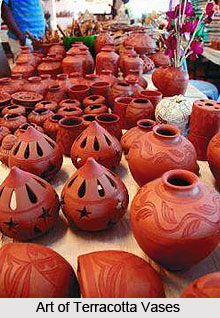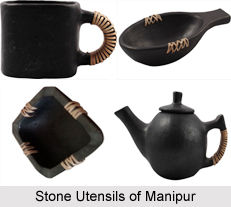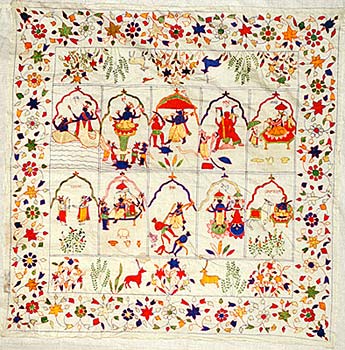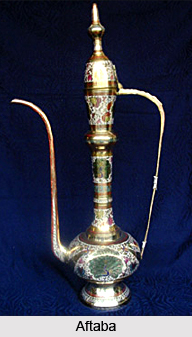 Terracotta Art in Gujarat is especially famous for its votive terracotta figures which are found in large numbers in rural Gujarat. Each figure of votive terracotta is offered to a deity and has a special significance. In Gujarat each significant act of life and rite of passage is marked by a special ceremony, often involving the offering of votive terracotta at a shrine. Shrines or sanctuaries can be found throughout rural Gujarat in such places as the summit of a hill, amongst the shade of trees or on a barren field; usually in a deserted spot but always emanating a mystical, spiritual aura. The shrines in Gujarat become vibrant with the presence of terracotta works that are present in them. In the shrines of Gujarat hundreds of clay figures are placed one against another in a mass of juxtaposed forms.
Terracotta Art in Gujarat is especially famous for its votive terracotta figures which are found in large numbers in rural Gujarat. Each figure of votive terracotta is offered to a deity and has a special significance. In Gujarat each significant act of life and rite of passage is marked by a special ceremony, often involving the offering of votive terracotta at a shrine. Shrines or sanctuaries can be found throughout rural Gujarat in such places as the summit of a hill, amongst the shade of trees or on a barren field; usually in a deserted spot but always emanating a mystical, spiritual aura. The shrines in Gujarat become vibrant with the presence of terracotta works that are present in them. In the shrines of Gujarat hundreds of clay figures are placed one against another in a mass of juxtaposed forms.
The terracotta figures may include horses, elephants, tigers, cows, bulls, buffalo, and replicas of insects or pests which damage the crops, as well as human figures. Dhabu is also a great form of terracotta work in Gujarat. They are dome-shaped houses which are offered to house the spirit of the dead. Of all the clay figures, the horse is the most important and offered the most frequently.
The custom in Gujarat involves that whenever the Tribals have to make an offering of horses or other objects they approach the potter to place an order and from this initial stage until the offering is made at the shrine strict rules and precedents govern every action. Where small offerings are made, the terracottas are taken to the sanctuary along with live chickens, incense, rice, coins, liquor and coconuts. For more important ones, everything starts with the sending of invitations to friends and relatives. Then the villagers, together with the paid (head of the village), the pujari (priest), the diwli (drummer), and the shehnai player (pipe player), all present themselves at the potter`s house. The terracottas are collected and the potter is paid in rice or maize as well as money, depending upon the size of the order. He is also given coconuts and liquor.
The styles and techniques of the terracotta figures vary from area to area, and ranging in size from 2cm to 1m high depending on the quality of clay. In south Gujarat, where the clay is not suitable for throwing, the terracottas are neither large nor entirely hollow, whereas in north Gujarat the clay is excellent for throwing and large hollow forms predominate in that area.
In Gujarat there are many Tribal gods to whom terracottas are offered, including ancestral gods, gods for crops, field gods, medicine gods and animal gods.
Terracotta offerings are made either individually or collectively and can consist of single items, or sometimes groups of clay figures numbering as many as 40 or 50. The reasons for offering are many and varied: at different stages of the crops` growth; for the general wellbeing of an individual or a village; to protect against ill health; as offerings to ancestors when installing the spirits of the dead; during the disease curing ritual; for infertility in humans and animals; when cows and buffalo do not give milk; to recover property after theft; and even if the devotee intends to commit a theft.



















